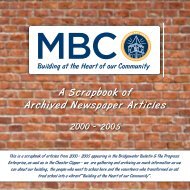Create successful ePaper yourself
Turn your PDF publications into a flip-book with our unique Google optimized e-Paper software.
It was a business.<br />
Ivan Westhaver loved the print shop. He stayed three years to get his grade 12. He<br />
didn’t want to leave.<br />
Some War Time Improvements<br />
Iron Fire Escape Built: 1940-45, Sneak Preview of Tests, Mischief<br />
New Fire <strong>and</strong> Fire Insurance Regulations required the building of a massive fire<br />
escape system, front <strong>and</strong> back of the school. In October 1939 the Board was obliged<br />
to initiate costs of installing. Provincial Fire Marshall, Mr. Rudl<strong>and</strong>, was involved in<br />
the planning. With exterior <strong>and</strong> interior work [exit doors to the fire escape] it became<br />
a long drawn out process. It was not until 1945 that the bulk of the work was done-by<br />
Leaman H. Hirtle, from West Dublin, a boss at Industrial Shipping.<br />
The monumental exterior iron stairs were a feature of the school for many years.<br />
Some remember the first h<strong>and</strong>-holding, some the first kiss. George Silver remembers<br />
when the boys figured out that, with a flashlight, at night you could mount the steps,<br />
shine the light through classroom windows <strong>and</strong> read the next day’s tests the teachers<br />
had written on the boards.<br />
Mischief makers, <strong>Bob</strong>by Mader recalls, soon realized the new potential for climbing to<br />
the tower <strong>and</strong> ringing the bell, <strong>and</strong> escaping, without entering the school building. See<br />
photos on page 153<br />
Classroom <strong>and</strong> Hall Lighting Installed: 1943-5<br />
Lighting was finally <strong>and</strong> belatedly installed. In his Principal’s Report for the year<br />
1942-3, Mr. Hankinson wrote, ‘Many of the children are going to have trouble with<br />
their eyes due to having to work during dark weather by insufficient light. This is<br />
a very serious matter. The Board of <strong>School</strong> Commissioners should take the earliest<br />
opportunity to have the school wired for electric lights.<br />
To their credit, the Board members, led by chair Evan Burgoyne, took immediate<br />
action. In December 1943, Donald Langille, who did electrical work for the Town <strong>and</strong><br />
had a daughter, Donna, in school, did the project, working at night. $250 was put in<br />
the 1944-5 budget to complete the installation. The student council added $60 to the<br />
funds. The classroom lights hung down five or six feet from the ceiling<br />
In the 1950s students like Franklyn Burgoyne carried on the work. The shop was<br />
later moved up under the bell in the tower. The aging equipment was eventually sold<br />
off.<br />
So the war came to a close. There had been a number of improvements not previously<br />
mentioned:<br />
Religious Instruction Course: Bible Study: 1942-3<br />
The piecemeal practice of teachers doing their own thing was replaced by a<br />
curriculum set by school representatives <strong>and</strong> a committee of local clergy. In his<br />
annual report, Mr. Hankinson noted: Bible Study: ‘The courses outlined <strong>and</strong> adopted<br />
in 1942 were followed this year. Memory work <strong>and</strong> other knowledge of the material<br />
covered were tested along with English <strong>and</strong> History examinations.’ The Bible Study<br />
period usually came first in the morning, following prayers.<br />
121





